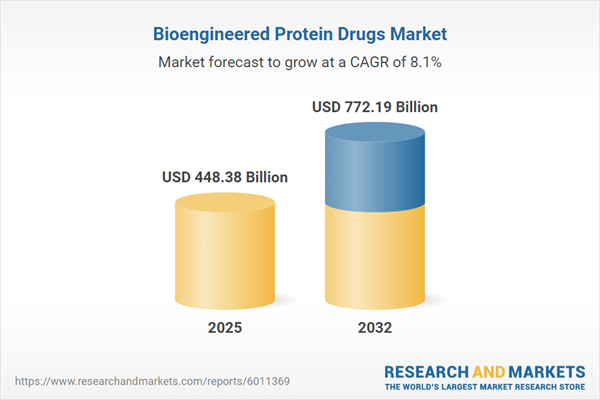Speak directly to the analyst to clarify any post sales queries you may have.
Senior executives navigating the bioengineered protein drugs market face a complex and fast-changing environment. Shifts in regulation, the rise of advanced technologies, and greater patient-centric care models demand a new level of market intelligence and strategic flexibility to ensure organizational success and sustainable growth.
Market Snapshot: Bioengineered Protein Drugs Market Overview
The bioengineered protein drugs market reached a valuation of USD 415.13 billion in 2024, with projections indicating expansion to USD 448.38 billion by 2025 and USD 772.19 billion by 2032. The compound annual growth rate (CAGR) is 8.06%. Market momentum is influenced by ongoing regulatory refinement, innovation across biomanufacturing, and increasing collaboration between major pharmaceutical companies. Organizations are modernizing their supply chains, advancing therapeutic portfolios, and adapting care models to keep pace with evolving clinical and commercial needs. Competitive advantage now hinges on strategic investment, technological leadership, and responsive partnerships that can address shifting demand worldwide.
Scope & Segmentation: Insights for Senior Leaders
This report provides targeted, actionable insights to support leadership teams in navigating the bioengineered protein drugs sector with confidence. Segment-focused intelligence supports informed decision-making, precise resource allocation, and alignment with critical growth areas across the following domains:
- Drug Class: Examines key biologics—including enzymes (such as alglucosidase and asparaginase), multiple monoclonal antibody types (chimeric, humanized, murine), PEGylated proteins, Fc/receptor fusion therapeutics, and recombinant proteins (erythropoietin, G-CSF)—alongside primary clinical mainstays like insulin and interferon. This analysis considers both established and pipeline assets to inform robust clinical and commercial strategies.
- Therapeutic Indication: Covers a broad range of medical needs spanning endocrine disorders (for example, diabetes, growth-related conditions), hematologic diseases (anemia, bleeding), immune and inflammatory conditions, infectious diseases, and all principal oncology categories. This enables organizations to refine R&D focus and optimize their global portfolios.
- Route of Administration: Assesses the impact of delivery routes—intramuscular, intravenous, and subcutaneous—on patient outcomes, therapy access, and institutional care coordination.
- End User: Identifies the evolving mix of hospitals, clinics, and home-based care providers as they support decentralization and extend advanced biologic care to broader patient groups.
- Technology Platform: Highlights the critical production systems—mammalian cell lines, microbial fermentation, and transgenic animal or plant models—required for scalable, compliant, and innovative biomanufacturing in diverse regional regulatory settings.
- Regions: Delivers an assessment of market dynamics, regulatory complexity, and infrastructure development across the Americas, Europe, Middle East & Africa, and Asia-Pacific, clarifying risk and opportunity in both established and high-growth markets.
- Featured Companies: Presents leading sector players including F. Hoffmann-La Roche Ltd, AbbVie Inc., Johnson & Johnson, Amgen Inc., Novartis AG, Merck & Co., Inc., Pfizer Inc., Sanofi S.A., Bristol-Myers Squibb Company, and Eli Lilly and Company, with a focus on their strategies and investment trajectories.
Key Takeaways & Strategic Insights for the Protein Drugs Industry
- The diversity of biologic therapies enables tailored clinical solutions, aligning organizational initiatives with shifting disease patterns and patient demands.
- Breakthroughs in genetic engineering and artificial intelligence are streamlining research, improving regulatory alignment, and accelerating time-to-market for both novel therapies and biosimilars.
- Enhanced collaboration between biopharma startups and established companies is resulting in accelerated drug development and effective market entry strategies in multiple geographies.
- Regional advances, notably in Asia and Europe, are widening access to novel treatments and fostering competitive, patient-centered ecosystem growth.
- Expanding decentralized care models and advanced logistics platforms are improving patient engagement and enabling near real-time outcomes monitoring.
- Agile manufacturing operations and adaptive supply chains are becoming vital to maintain global quality and address evolving compliance demands.
Tariff Impact on the Bioengineered Protein Drugs Supply Chain
Forthcoming changes to U.S. tariffs are prompting manufacturers to invest in more resilient supply chains. Strengthening supplier alliances, increasing regional production capacity, employing flexible inventory systems, and diversifying sourcing practices are central to minimizing disruption and ensuring continuity in a volatile trade and regulatory climate.
Methodology & Data Sources
Findings in this report are based on direct interviews with sector executives specializing in research, regulatory strategy, and supply chain operations. Information is validated by scenario modeling, targeted roundtables, and examination of peer-reviewed external publications to ensure accuracy and decision relevance.
Why This Report Matters for Senior Leaders
- Enables effective use of emerging technologies and better operational strategies throughout the bioengineered protein drugs landscape.
- Delivers market benchmarks and focused insights, equipping teams to act decisively and navigate complex environments.
- Provides foresight to anticipate industry trends, manage new risks, and achieve long-term, sustainable value.
Conclusion
This report equips senior leaders with the strategic foundation needed to adapt, identify new opportunities, and reinforce organizational resilience in a complex marketplace shaped by regulatory and technological change.
Additional Product Information:
- Purchase of this report includes 1 year online access with quarterly updates.
- This report can be updated on request. Please contact our Customer Experience team using the Ask a Question widget on our website.
Table of Contents
3. Executive Summary
4. Market Overview
7. Cumulative Impact of Artificial Intelligence 2025
Companies Mentioned
The companies profiled in this Bioengineered Protein Drugs market report include:- F. Hoffmann-La Roche Ltd
- AbbVie Inc.
- Johnson & Johnson
- Amgen Inc.
- Novartis AG
- Merck & Co., Inc.
- Pfizer Inc.
- Sanofi S.A.
- Bristol-Myers Squibb Company
- Eli Lilly and Company
Table Information
| Report Attribute | Details |
|---|---|
| No. of Pages | 190 |
| Published | November 2025 |
| Forecast Period | 2025 - 2032 |
| Estimated Market Value ( USD | $ 448.38 Billion |
| Forecasted Market Value ( USD | $ 772.19 Billion |
| Compound Annual Growth Rate | 8.0% |
| Regions Covered | Global |
| No. of Companies Mentioned | 11 |









